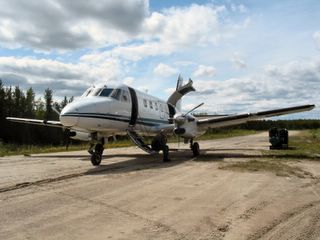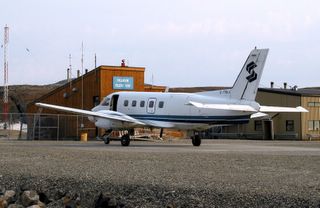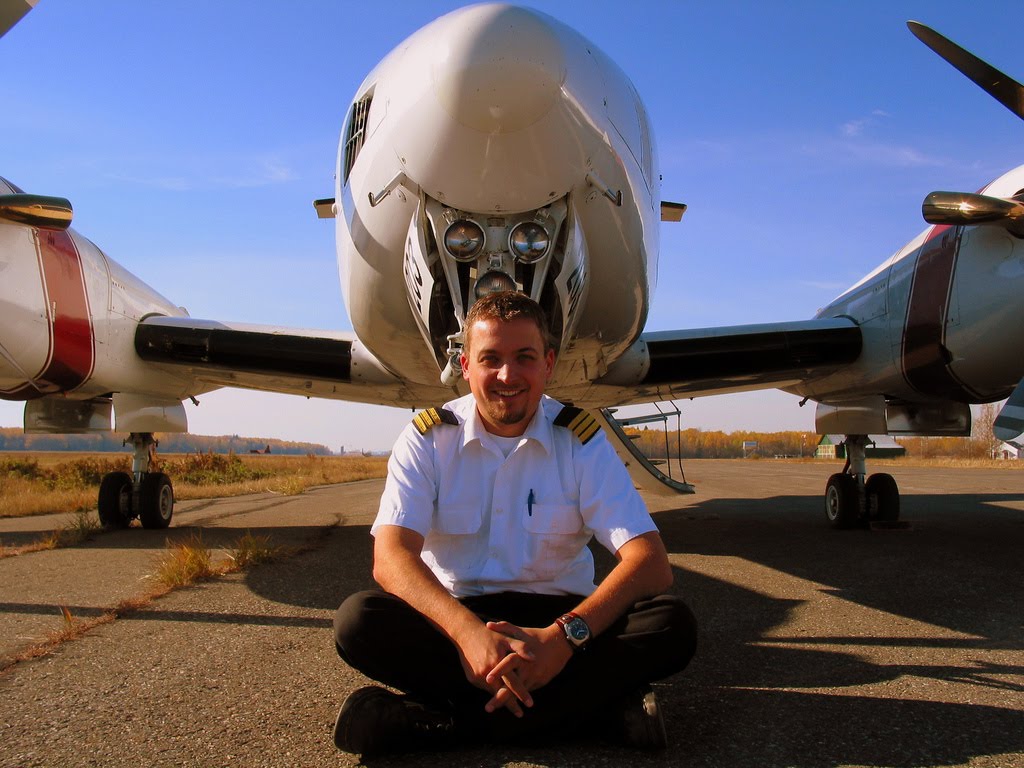The Embraer EMB110 Bandeirante

The Bandit 
On April 29th of 2004 I did a ride and gained a type rating on The Brazilian made Embraer Bandeirante. At first, I really didn't have a whole lot of desire to fly the Bandit. I didn't find it an attractive plane, nor did I think I would enjoy the work that it did. However, after an entire summer of flying, I found that my opinion was completely changed. I really, really, liked flying the Bandit.
Originally designed in the 1960's (the models I flew were all built in the 80's) the Bandit remains Embraers most successful commercial aircraft. The company was formed with the mandate to fulfill the Brazilian government's needs for a general purpose light transport aircraft for their military. Many different models have been made, all for different purposes. Maritime patrol, aerial photography, commuter airline, executive transport and more. The type Skyward flies is referred to as the EMB110P1, a passenger/freight model with the ability to quickly take seats in and out and sporting a larger rear door for loading freight. Skyward has two different seating arrangements, two 15 seaters, and two 18 seaters. This aircraft was made to carry out the missions that Skyward requires of it. We would routinely have maybe 4 seats up, taking 4 passengers to a community, and fill the rest of the space with over 2000lbs of freight. Once the freight was unloaded @ the community, we could put in the remaining seats and take up to 18 passengers out. That made the Bandit a great plane for sched flights around Northern Manitoba. Embraer ceased production of the Bandit in 1990, after building over 500. Currently, 15 EMB110's are registered in Canada.
The Bandit was hauled through the air by two Canadian made Pratt and Whitney PT6A-34 turbine engines, each producing 750 shaft horsepower. The Reliable PT6 engines spun three bladed, constant speed, reversible Hartzell props. In the air, each PT6 burned roughly 300 lbs per hour giving the aircraft a cruise speed of 190KTAS. We flight planned a block fuel burn of 650 lbs per hour for the 1st hour, and 600 lbs and hour after that. In the wings we could take on close to 3000lbs of jet fuel, giving the Bandit a range of over 900NM and around 5 hours endurance. Typically, the Bandit weighed 7900lbs empty and had a max take off weight of 12,500 lbs. The panel on the right side changed with each airplane, however, the left side always had an HSI, and an RMI. Although the Bandit has the option for an autopilot, Skyward chooses not to have one on their aircraft. Three airplanes carry the KLN89B GPS, very modern, and very nice to use. The fourth has an older style apollo GPS, which works fine, but isn't as nice as the KLN89B. The airplanes are full IFR certified with two VHF radios, two VORs, two ADFs, and two transpoders. All aircraft have a weather radar, and one has a storm finder. They're also certified for known icing sporting a very good anti-icing/de-icing package. The Bandeirante is non-pressurized, and Skyward does not have an oxygen system in any of their Bandits. Our operations then take place @ 13,000' and below. Other intersting systems on the Bandit are the air conditioning system, which worked great in the summer, and the ground steering system, consisting of a tiller (small handle) on the left hand side of the captains seat.
Skyward uses the E110 mostly for scheduled flights out of Thompson, and on charters. Skyward has regularly sent the E110 on many missions in Canada's Arctic. Kenn Borek also flies the E110 on charters and scheds out of Cambridge Bay. Oddly enough, a plane made in Brazil is amazingly suited for flying in the harsh conditions of Canada's Arctic. The Bandit is also used regularly for cargo hauls. One such cargo trip saw use taking a 2000 pound generator and some propane to Gunisao Lake Lodge and bring out the old 2000 pound generator and an ATV. It would take roughly 20 minutes to take the aircraft from cargo configuration (only three seats up) to full passenger configuration (eighteen seats).
Part of the fun of flying the Bandit was the two crew environment. This airplane is the 1st I've flown with standard calls and standard operating procedures(SOP's). SOP's exist to create a standard amongst crews flying that airplane so that each pilot knows exactly what to expect from the other pilot they're flying with. They consist mostly of standard calls and standard methods of flying the airplane. They also spell out the responsibilities of each crew member for every aspect of operating the aircraft, from the preflight in the morning, to include emergency procedures, to putting the aircraft to bed @ night.
The Bandit is also the first aircraft I flew, outside of college, that operates IFR. I'm incredibly grateful I started flying IFR with experienced captains. They were able to let me fly approaches, and offered great advice afterwards on how to fine tune my IFR abilities. For the first, probably dozen flights or so, it was like drinking from a fire hose. I learned a lot flying the Bandit IFR. Most approaches I did took place in uncontrolled airspace, where there were no vectors from ATC and we maintained our own separation, through radio calls, from other aircraft in the area. Except for Thompson, all the other airports I fly to have non-precision NDB approaches. Once inbound to Thompson, we have the option of ILS, Localizer backcourse, NDB, and NDB/DME approaches. Inbound to Thompson is also the only time we are in Controlled airspace, requiring us to comply with instructions from ATC, under the watchful eye of Winnipeg Center. The experienced gained flying right seat on the Bandit is a huge benefit to me now, flying single pilot IFR.
After 460 hours of great flying on the Bandit, she has become my favourite plane out of all those I've flown. In October I did my last flight on the E110 before being tasked to the Cessna 208B Caravan. I hope to go back to the Bandit as a captain within the next year.
"SKJ" in Ivujivik, Quebec 

Outbound from Gunisao with Generator and ATV 

Panel "SKJ" 
Other Embraer EMB110 Photo's on Airliners.net




1 comment:
Excellent read. Thanks.
Post a Comment